First trip to Peru
By Anita Evans
Please read the disclaimers
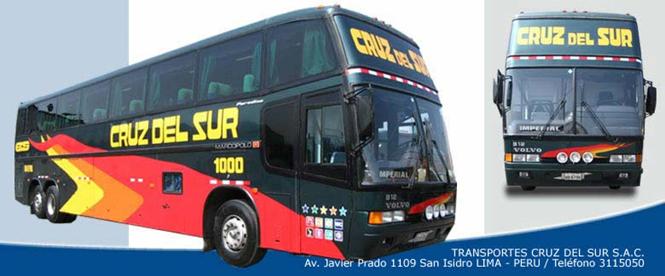
5 AM (Friday 10th April) sharp: Jose, Leonor (our friends)
and Manuel (our driver) were at the gate. We loaded our bags into the back of the
pick up and climbed into the back of the cab. Manuel has a twin cab pick up however it is
still a squeeze when you have 5 adults and 1 kid plus several backpacks and items
of food crammed into it.
If you think NZ roads a winding and twisting think again. They are
straight compared to the roads we travelled on to the Ecuador/Peru (E/P) border.
We twisted our way through the Andes Mountains at times climbing
up and up like we were heading to heaven. Several times when we were traveling along
and you look down and you see nothing but clouds below; we were that high up. Absolutely
breathe taking and beautiful!!!!! At times it felt like we were on top of the world.
The scenery was lush and green (it is rainy season). Jose said that
when they came through the same route in January it was all brown like a desert.
The road is blocked in parts or more precisely absolutely covered
in a rock land slide and big as 4 stories. The council has cut diversions around
the land slides. They allow one lane of traffic through at a time. There are not
controls for the flow of traffic and you can’t see what is coming the other way
as landslides tend t happen on bends here. So you just go for it.
There is one landslide which I’m not sure how they will clear as
the rocks are huge. Too big for any digger, they are boulders; they’d have to blow
them up or something. Or cut a new road around the giant boulders.
We spent 4 hours going up and down mountains. The road runs along
the edge of the mountains. It’s a pretty good road bar the land slides. If you look
outside the window and there are no clouds to block your view you look straight
downnnnnnn as far as you can see, got a slight case of vertigo a few times.
As we approach the town of Macara (the last town in Ecuador before
we crossed the border) we hit a traffic jam. A rather unexpected thing to hit. There
were not many cars or buses or trucks on the road as it was Easter Friday and no
one works on Easter Fridday. Yet we hit a traffic jam.
Easter here is unlike Easter
in NZ. Easter here is for real! It has not been taken over and turned into a commercial
affair with trillions of eggs in various sizes, made from various colors and types
of chocolates covered in a multitude of colorful wrappings.
No, Easter here in E holds its true meaning, honoring and remembering
the resurrection of Christ.
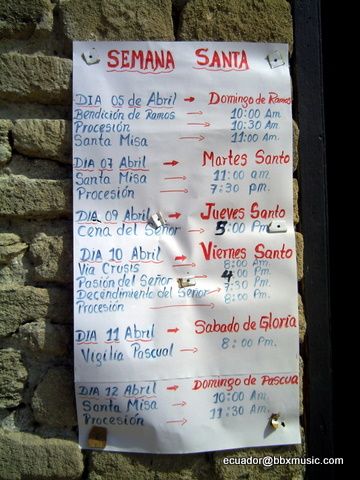
The traffic jam was caused by a pilgrimage of people from the local
district that were walking on the main road, down into the town of Macara to go
to church. I’d say there were a few hundred people in that peaceful procession.
They would stop often where a person would speak aloud; I think some kind of prayer.
It was coming onto mid day when we hit this pilgrimage and it was
getting stinking hot. We crawled along (very slowly). People started to join the
walk and pass our Ute. One group of men paused to look into the back of the Ute
at which time Jose said ‘someone needs to get out and sit in the back’. Given that
Pierre and Leonor had got out earlier and were now ahead of us walking with the
people and Emily was ruled out because of her age and Manuel because he was driving
that left me or Jose. Jose had dropped the passenger seat back by now and was quite
comfortable so I took his question as that meant me.
So I got out and into the back. Honestly, I didn’t mind. It gave
me something to do. Got me out of the stuffy cab and I was able to enjoy the happenings
around me a lot more. No one else paused to look at the back of the Ute. Pierre
came and joined me for a while. All in all it was a cool experience. Figuratively
speaking as it was scorching hot in the back of that Ute with the sun blazing down.
It took us about 2 hours to do the last 3 ks into Macara. Fortunately
the parade vared off just as we got to Macara in a different direction that we needed
to go. So we had a quick pee pee stop and headed for the border.
The border crossing is a bridge
that spans a large river. 1st we stopped on the E side. There was no
queue and no problems it took about 20 minutes. Then you walk across the bridge.
(Manuel drove the Ute over) to the Peru side. This side took a little longer as
there is more paper work on this side and you have to go to the immigration post
and then to the police post.
Manuel had to go to a 3rd office the ‘transport office’
to get a certificate to display in the front window of his Ute. He is a taxi driver
in E and his Ute is the Taxi as is the case with all Vilcabamba taxi’s they are
Ute’s (no doubt due to the amount of dirt/mud roads we have here in V). In order
for him to drive in P in his taxi he has to get approval (and be registered first
which he is) from the P traffic office.
All in all with a loo break thrown in it took about 45 minutes at
the P border. It was a hassle free non eventful process which is the best outcome
you can have when going through customs.
And voila we were in Peru!
The roads in P are very different then the mountain road we had travelled
on coming from V. they are flat as flat can be in P and as straight as straight
can be and they seem to go on forever. We traveled on dead straight road for 3 hours.
The scenery changed quickly within 40 minutes we were in the desert.
It was flat for as far as you could see in all directions. The shrubs were black
from being burnt by the sun. There was no soil just sand. Jose was telling us that
the rains come once every 7 years in this desert. That the rains came last year
which is why we still had a far amount of green around us. But you could see a year
without rain was starting to take its toll on some plants. He said that many plants
survive on this rain once every 7 years.
It would be a good time to add that people live in this desert. There
are little ramshackle settlements scattered along the way. Bloody amazing if you
ask me how anything lived out there. Some of them are made from mud some from just
woven bamboo. On quite a few were some satellite dishes so they could get cable
TV. It was kind of odd t look at this ramshackle hut with a satellite dish on it.
I asked a friend how they could afford such a thing. He explained; they live very
poor lives these people in these desert towns with no real hope of improving their
lot so the TV gives them and escape from a reality that is in escapable. Well that
could be said for people in NZ too.
It was stinking hot. We were very fortunate to have air conditioning
in the Ute.
Now let’s talk rubbish for
a moment. I mean let’s talk about rubbish. THERE IS RUBBISH EVERYWHERE IN THIS DESERT
FOR AS FAR AS YOU CAN SEE.
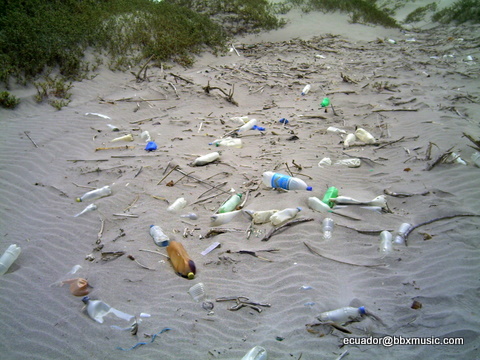
People actually come in their cars and drive into the desert a bit
and dump their rubbish. The council dumps the rubbish in the desert too. It’s like
driving through a rubbish dump for hours.
It’s just everywhere. It’s a mind blowing sight that at first makes
you cringe and want to flee. But then I thought to myself "Is this much different from Western ways?" From our rubbish
dumps? No seriously let’s think about our systems for dealing with rubbish.
I watched a documentary in NZ before I left about the fact (and I
mean hard fact) that Britain loads its rubbish onto
ships and this rubbish gets dumped in villages in China for example.
The doc crew found an old power bill from a guy in Britain at a dump site in China
that was right next to a village and they took it back to the guy in Britain and
knocked on his door. Needless to say he was rather shocked at the tale of where
they go his power bill from. Kids in the village play in the rubbish which is about
a story high.
Let’s look at our rubbish management systems in NZ. As you drive
out of Nelson to Picton you go along Queen Elizabeth II drive. There is a lovely
park on your right where the new cycle way has been built and children play and
the kit flying day is held etc. This was the rubbish dump for Nelson! In NZ when
our rubbish dumps get full we cover them over with soil and plant trees and grass.
But underneath this pretty façade that our kids play on is a septic time bomb. With
gods knows what seeping out into our sea and water ways. Talking about sea lets
not go there about what we dump in our waters in NZ.
So I got to thinking are we really, when you get down to the nitty
gritty, any better than Peru and the dumping of rubbish in the desert? At least
in the desert it is in your face, obvious not hidden and called a ‘park’.
The only way to deal with rubbish is to not create the bloody stuff
in the first place! STOP using those plastic bags. Stop buying stuff in plastic.
If everyone refused to buy stuff wrapped\contained in any form of plastic then the
manufactures would have to change.
Back to our trip in Peru.
Our first destination was a place called Colan, a beach in fact.
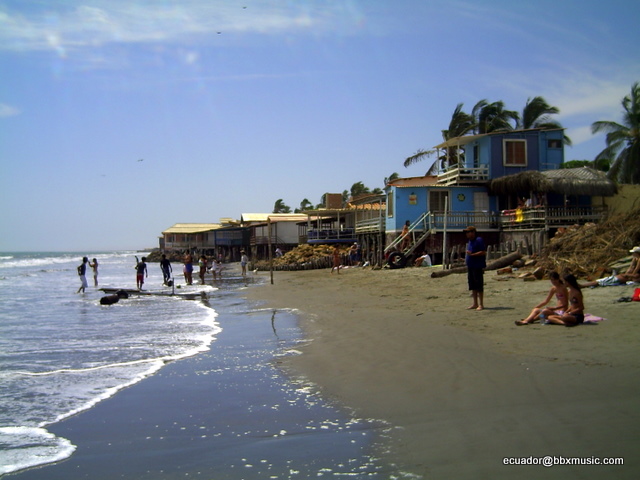
Colan Description
Just 15km / 9mi north of Paita is the small town of Colán. Although
there are beautiful beaches all over the far north coast of Peru, the Colán area
has some of the best. The beaches of Esmeralda and Palmeras are a great place to
soak up the sun and enjoy the warm water that laps the white sand. Homes on stilts
from the 1950s line the beach.
The Iglesia San Lucas in Colán is the oldest church in Peru. It was built in 1536
by Dominican friars. There is not a lot else in Colán and service for travelers
are limited to the resorts. http://www.planetware.com/piura/colan-per-pi-c.htm
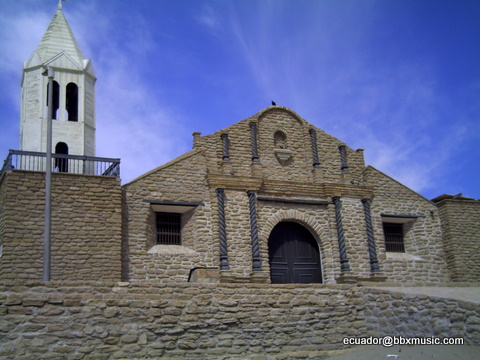
We seemed to drive forever with no sign of the beach in sight. Then
wham we came around a bend and there it was. Like it appeared out of thin air. There
was a small settlement with some scattered trees, ramshackle houses, some cobbled
roads and the oldest church in Peru immediately in our view. And in the distance
there was a long row of palm trees and hotels and houses. And the ground was desert.
We drove through the settlement. The school for this village was very large and
in very good condition. There were not that many stray dogs and it was pretty tidy
and clean. Unfortunately I cannot go as far as to say it was beautiful. For it was
barren desert with little color or plants.
A few minutes’ drive further and we were in the beach settlement.
It took an hour to find a hotel with a room big enough to take Jose, Leonor, Pierre,
Emily and me.
The hotel we stayed in was very nice and surprisingly the room was
quiet. There were 5 of us in the room and we were over the outside dining area.
But this dining area was only used during the day not at night. The hotel doesn’t
supply towels or loo rolls as the Peru guests here take them. So we had to ask from
some towels. We had packed a couple of loo rolls as I had anticipated this. Most
public toilets and even restaurant toilets don’t supply loo paper and more often
than not there is no toilet seat. So you learn to squat and carry a loo roll with
you where you go. And I mean whereever you go. I always have a loo roll in my bag
even in V.
The coast that the beach is on is the opposite side of the Pacific
Ocean to NZ. After we settled in we went to the beach. By now it was 6 pm and Jose
wanted to go for a swim. But the water was cold just as cold as in NZ at 6pm at
night. But I wasn’t going to let the Kiwi side down and decided to go in. Shit it
was cold. Jose followed me in. I managed to stay in for about 10 minutes and even
put my head under for a second. It was really good surfer so we mucked around in
the surf for a bit. So I have sum in the Pacific Ocean in Peru.
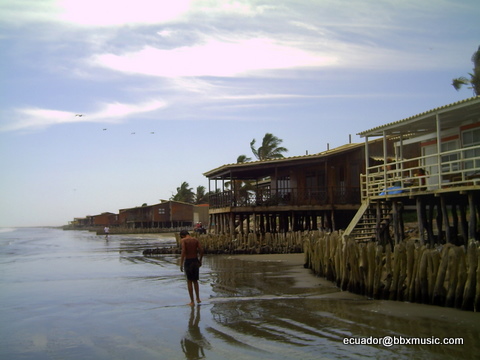
How to put Colan into words ….. the thing is when you have lived
in NZ and in the Pacific and visited Aussie and Fiji etc you have been very spoilt
for beaches. So I do not compare Colan to NZ as there is no comparison. I will just
describe what I saw.
There is no shopping as such on in this beach town it is predominately
restaurants, pubs, and hotels, and resorts. It consists off one main street running
for a couple of Ks. On the desert side is all the pubs, accommodation etc on the
beach side of the street is private houses that are all protected by high concrete
walls and solid gates. There are a few little pathways between houses to allow the
tourist to the beach. Or you can cross an unfinished construction of a house and
get access that way.
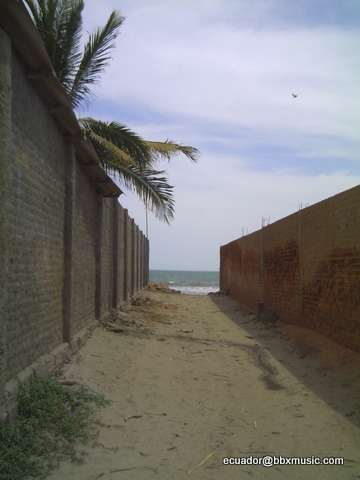
The beach itself is white sand. But unfortunately is it spoiled by
rubbish. The surf is very good. There are houses that are built on the sand some
of them have been standing for 60 years. As the tide comes in it goes under the
house. Pretty cool you can hear the water under you floor when you sleep.
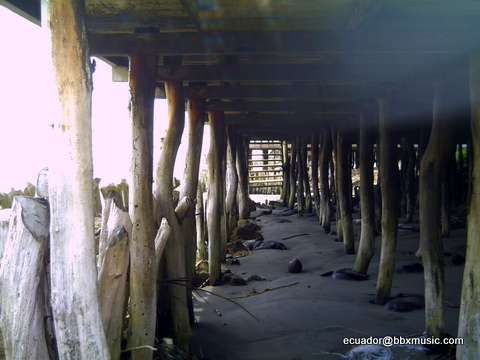
As we walked back to the hotel from our swim we called into a local
shop to buy a bottle of water to drink. I paid for the gallon of water ($2). As
we were leaving Pierre spotted a good chocolate bar for us to share so I asked the
lady for one. I handed her the money she asked for then her husband ‘stuck his nose
in’ to spite a better term and said we needed to pay for the water too! So, I wasn’t
having that after a clear statement from me that we had already paid we got into
a debate about the step by step dialogue of us paying. After a few minutes of a
circular conversation (and the woman who we had dealt with had withdrawn herself
and was avoiding the conversation) I got a bit agro with the guy and returned the
chocolate bar collected my money for the bar and we left with our paid for bottle
of water. I hit this in Egypt a few times paying for something then the store keeper
saying you hadn’t paid for it just as you were about to leave. It’s only $2 but
I’d paid once and once is enough. I’d paid too much for the water in the first place.
He didn’t stop us from leaving as we had paid he was just trying his luck. However,
it did not leave a good taste with us about the hospitality in Colan and I’d advise
travelers to another beach. We did have a very good dinner at the restaurant of
the hotel then we crashed.
The next day we hired a local guy and his
car. The car had no back window as you can see in the photo
below. He had solved the ‘falling seat problem’ (remember Phil the same problem
we had with the driver’s seat of the white car in Auckland) by tying a seat belt
around the pillar between the doors on the right, running it behind the seats and
tying the other end around the pillar between the doors on the left. You can see
it in this photo.
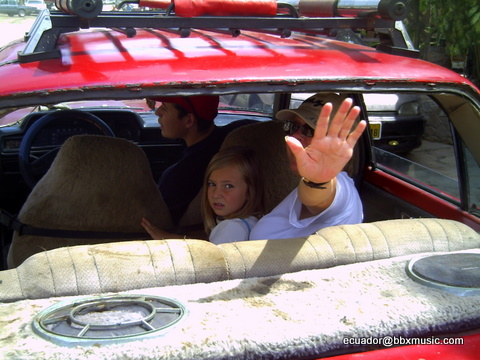
Look ma' no window
The plan was to go to the next village for a look. You have to drive
along a desert dirt road out of the settlement of Colan towards what appeared to
be nothing but desert with some trees in the far distance. We got about a 3rd
of the way when we rolled to a stop. We had lost our brakes. The fluid had poured
out over the back right wheel axle. So we piled out and went for a walk across the
sand dunes, dogging the rubbish to the beach while the driver went on and found
a spot to turn the car around. When we got to the beach we were looking out at an
oil rig. There is a lot of drilling for oil around Colan.
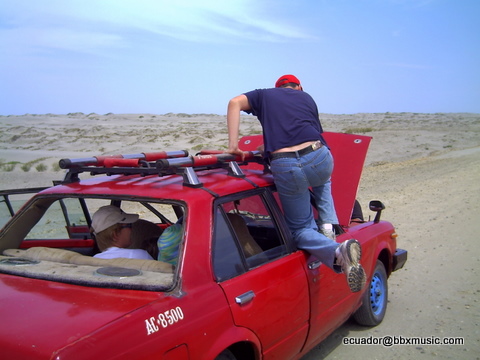
Getting out of the car through the window as the passenger door does not open
So when the driver returned we got back in and headed back to Colan.
Fortunately the area is dead flat and there were no other cars. So we had no need
to break. He drove very slowly and very well. We got out once we got to the town
and the driver went on on his own. There is a lot of traffic in Colan given its
small size and I for one did not fancy going in the traffic in a car with no brakes.
The brakes were the least problem that could have happened. I wasn’t
a bit worried (while there was no traffic). We still had steering, the clutch still
worked and the gear box still worked and the engine etc. basically the car still
moved. Otherwise it would have been a very long 5 k walk in the desert back to Colan.
So all in all it was a bit of excitement and fun for the morning.
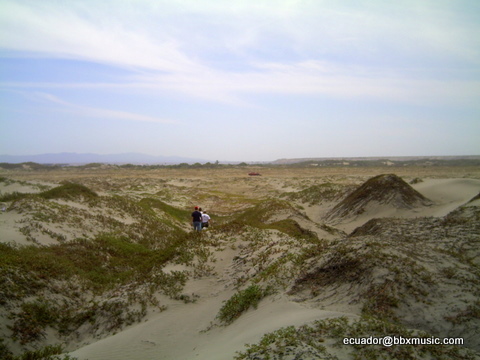
Walking back to the car
Back in Colan we did a bit of sightseeing we went to the old Church.
The Iglesia San Lucas in Colán is the oldest church in Peru. It
was built in 1536 by Dominican friars. There is not a lot else in Colán and service
for travelers are limited to the resorts.
http://www.planetware.com/piura/colan-per-pi-c.htm
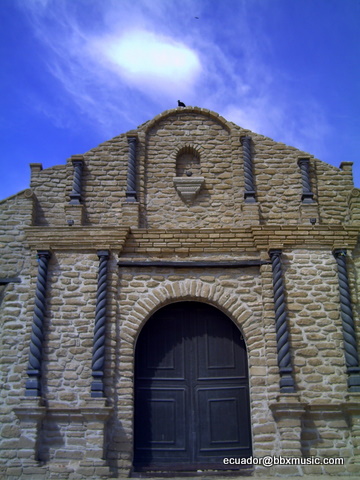
Then we went and hand some lunch at one of the resorts. This one
is at the far end of town and is made up of raised bure’s and a restaurant. It sits
right on the beach, very good quiet location. The meal was excellent.
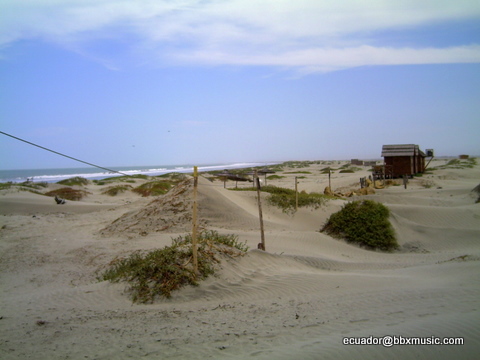
Then it was time to pack and get a taxi to Piura to catch the bus.
It was an uneventful trip into Piura just another hour on desert roads. We arrived
a Cruz Del Sur bus terminal in good time and the bus departed on schedule a 6 pm.
It’s a two storey bus and it was full.
We drove for 3 hours until we reached a town of which I can’t remember
the name at 9 pm. Where the bus stopped at the Cruz Del Sur terminal there and picked
up dinner (and breakfast). We then were off again. We were served dinner which I
won’t write home about, put it that way. Emily fell asleep straight after dinner
and didn’t move till the morning. They then played the movie Con Air and the lights
were finally turned off on the bus around 11 pm.
We were up stairs in second class. The seats go back about as much
as on a plane and you have about as much leg room as on a plane too. I took two
herbal sleeping tablets and managed to get some sleep, though not good quality.
Surprisingly no one snored during the night! J No one farted either and it was relatively
quiet onboard. The ride was very smooth, very good drivers. There are two on board
and they do shifts the bus doesn’t stop after the dinner pick up.
During the late evening (while I was still awake waiting for the
movie to finally finish) I’d look out the window when we went through a town as
the street lights enabled me to see quite a bit. (or passed a desert town). Being
up on the second level of the bus I had a good view.
What got my attention the most was the vastness of the desert towns.
These are towns consisting of mud house one level high. The land is flat; there
are little or no trees and no color. Everything is a grey\brown except for the orange
street lights the go on and on for as far as you can see. They are huge towns. I
pondered about the people that lived in these desert towns, what their lives were
like, what they felt, what they did, how they feed themselves. When you see these
places you realize that we westerners have nothing to complain about in our lives.
We have too much of everything. We are very
comfortable and we have no real idea of what it is like to be poor. We have really
no idea of what it feels like to have no hope of changing your lot in life.
It rocks you to your core.
We were woken by the waitress serving us breakfast which again I
will not write home about. We arrived in Lima on scheduled at 9 am.15 hours on a
bus. When I got off and sat down in a chair at the terminal I still felt like I
was moving as if still on the bus. A bit like you get when you get off a boat after
being on it for a few days.
Lima is ENORMOUS. We got a
taxi to our friend’s parents house which took about 45 minutes. They live in a gated
community in Southern Lima. The community is right by the beach. We shared a very
nice 3 bedroom apartment with our friend which is on the same property as the parent’s
house. We were a 5 minute walk from the beach. After settling in and having a pizza
and salad we went to explore the beach.
The beach made 90 mile beach in NZ look like a toy. This beach went
on and on. It was a wide white sand beach. There is a lot of under toe in the water
and it drops away very quickly in the water so there is no swimming. There were
a few people on the beach as there was a resort that faced onto the beach.
The houses in the gated community all have 3 meter high solid concrete
walls around them with either iron or wood gates. So you’d think that was pretty
secure. On top of these massive walls running the entire perimeter around is 3 to
4 rows of mains voltage electrical fencing. Like what you’d see on top of say a
prison. Every time we drove through the community I’d look at these walls and wire
and just think WOW. I know this is not the only place in the world that has walls
like this i.e South Africa. But to see it and live in it myself even for just a
few days just blew me away. I am if nothing else here in E and P and Latin American
gaining an appreciation and compassion for how other people have to.
We live pretty safe and free in NZ.
During this time of year in Lima there is a mist in the air most
days. The mist rolls in from the sea. So when you look into the distance everything
gets lost in the mist. Everything is kind of ‘misty’.
After our walk on the beach and burying Pierre in the sand we headed
back to the house for a Siesta. I fell asleep just out like a light. Pierre slept
a little and Emily nothing she went next door and played.
In the evening our friends took us to the local shopping mall. One
of the reasons for this trip was to compare prices for electrical goods and house
hold goods and buildings materials etc with those in E as we had heard the P was
cheaper to buy in then E.
It was a huge mall!! With 3 big mega centre’s attached to it. I’d
say I have been into the biggest supermarket ever in my life in this mall called
Metro. It was just huge. To big I couldn’t stand being in there.
And the people. We were there Sunday night and the people, waves
of people coming in then waves going out. It was hard to move around the mall due
to the volume of people in it. Remember Lima is a city of 10 million. They have
traffic police directing the traffic in the parking lot.
We had a good look around. When we converted prices we found that
things like cloths, linen, household small goods, electrical etc were only marginally
cheaper than in E and more expensive then in NZ.
The only items we bought were a pair of tramping boots for Pierre
and me and a pair of shoes for Emily. Shoes were cheaper. We bought food supplies,
or more precisely Pierre did, at Metro as I just couldn’t bare being in there. We
left around 9 pm at which point the home centre (like a big Mitre 10 mega) was closed.
The people had dropped off in the mall but the mall and the other super stores were
still open.
The next day was Monday and after breakfast we headed out to explorer
Lima without our guides (or friends). We had read and been advised not to take public
transport, to be very very careful when taking a cab and to not carry wallets or
wear jewelry. To put your money in your socks, bra (if you wear one), disperse it
around your body. To watch your bag to be paranoid with Emily etc etc.
So some of this we took to heed and we did not wear jewelry not even
our wedding rings. We dispersed our money around out bodies. We did carry wallets
but well buried deep in our front pockets. I stuffed loo paper on top of my wallet
and put some in my other pockets so any pick pocket would get a hand full of loo
roll. We made sure Emily was holding one of our hands.
I packed old cloths for us to wear nothing flash. We wore out new
tramping boots too.
Monday morning we got the taxi driver we had used from the bus terminal
(very good guy) to take us to Miraflores distract. A very touristic district of
Lima.
Miraflores is a district of the Lima Province in Peru.
Known for its shopping areas, gardens, flower-filled parks and beaches, it is one
of the upscale districts that make up the city of Lima.
Originally founded as San Miguel de Miraflores, it was established
officially as a district on January 2, 1857. As a result of the Battle of Miraflores fought during the
War of the Pacific, Miraflores got the designation of Ciudad Heroica ("Heroic
City"). The current mayor is Manuel Masias.
The district is full of cafés, pubs, restaurants and shops, which
is a draw for a large part of the Lima population on Sundays. Parque Kennedy, Miraflores'
central plaza, regularly has flea markets and art exhibitions. Larcomar, a shopping
mall overlooking the Pacific coast, is located in Miraflores, and is very popular among tourists,
young people and people of the medium-to-upper-class socioeconomic levels. They
have restaurants, stores, a food court, ice cream shops, arcades, bowling alleys,
nightclubs, bars, and the most modern cinema in all of Lima
http://en.wikipedia.org/wiki/Miraflores_District
Miraflores is a beautiful place and well worth at least a day if
you every get to visit Lima. We went to Parque Kennedy first with the taxi then
headed on foot to explore the area. First stop, as we were hungry, was ………………… Burger
King! I know, I know we were in a fantastic new city and should have tried the local
cuisine but it’s been months since we’ve seen a decent fast food place. Okay some
may not agree that BK is a decent fast food place but it’s better than MacDonald’s.
They have KFC and Pizza hut in Loja but we don’t eat these.
So we shared a burger and chips P and M and Emily had a kids meal.
Then we went and explored the Artisan area of Miraflores where they sell all the
‘touristic stuff’. Much of which is very beautiful vibrant colors, stunning fabrics
for example. We refrained from buying much. We bought a fabric and leather backpack
which was an item specifically on our shopping list. It’s a local bag used here
very strong and secure as it uses old fashioned buckets as fasteners not zips or
plastic clips., very good for taking on bumpy rides like horse ridings as it won’t
open of its own occurred and all your belongs fall out J
There is a whole long street of malls made up of 20 or so artisan
shops after a few malls we were ‘artisaned out’. We had spotted a large electrical
appliance mall on our way in in the taxi so we popped in to check out prices of
printers, cameras, fridges etc. the printers were of equal prize to NZ the camera
and fridges etc more expensive but the sewing machines were a lot cheaper. We didn’t
buy anything due to the logistics of getting it back home over two days, 2 bus trips
and multiple taxi rides.
To make up for BK we had a nice local lunch in a very nice restaurant.
Back at Parque Kennedy we wondered what to do next. Take the 1 hour
tourist bus tour around Miraflores or go to Plaza Mayor (central plaza of Lima).
We opted to go to the Plaza but not by taxi. No, by local bus! We got info on what
bus to get and where from the information centre and headed off.
The Plaza Mayor is at the exact location where Francisco Pizarro
founded Lima. In this plaza some of the most excellent facts of the history of the
country have been developed. Initially, there were small stores and commerce. Also,
it was the scene of in excess of bulls and served like the site of execution of
the condemned until death by the Court of Santa Inquisición. In 1651, a bronze battery
was placed in the center of the seat that lasts to date. It was in the Plaza Mayor
where it was proclaimed, in 1821, the Act of Independence of Peru. It is surrounded by the Palace by
Government, the Municipality of Lima, the Cathedral and the Archbishop's Palace.
http://en.wikipedia.org/wiki/Historic_Centre_of_Lima

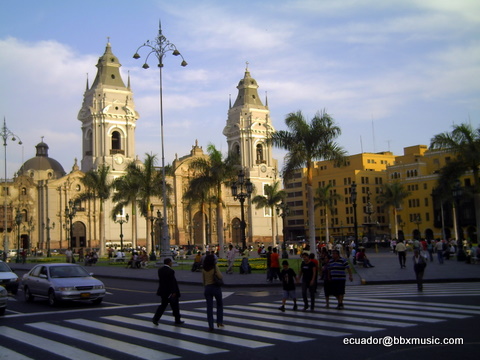
Now I will take a moment here to describe the traffic in Lima. There are cars, buses, taxis, Tuck Tuck’s, trucks …..
everywhere. The motorway we travelled on coming into Lima from the bus station is
4 lanes wide on both sides. There are buses every. They are the buses that the western
world has ‘thrown out’ some of them look like they came out of some old 1950’s movie.
Like the old American yellow school bus you see in the move Forest Gump (except
they are not yellow). Shit they are old buses. Or they are mini vans that are used
as buses. Old mini vans. All buses and minis vans have a driver and a conductor
who hangs half out of the vehicle as it goes along yelling out to people where the
vehicle is going to next to try and get people on board. They cram people in these
buses and minis vans. Honestly when some buses went past use we couldn’t make out
one person from the other as they were so crammed in!
Then there are the taxi’s. The little, very little yellow taxis with
half their metal bits falling off!! Or the Tuck Tuck’s like what you see when you
visit Thailand. These 3 wheeled vehicles that consist of a motorbike with a seat
and frame holding a canvas roof attached to them. There is Tuck Tuck’s everywhere.
If you walk along the street and you are a foreigner they honk at you (taxis and
TT’s) as they drive pass and slow down to see you if want a ride. This wouldn’t
be too bad except it happens every minute or less. Or there is someone trying to
sell you some cheap plastic thing or food. So you find yourself constantly saying
‘no, gracias’.
So we found the bus (mini van) which we were told to take and got
on. It’s too far to walk from Miraflores to Plaza Mayor it’s 8 ks. Both are in two
different districts of Lima. We managed to get seats and fortunately for us the
conductor didn’t pack the mini van bus to bursting point. Can’t say it was a comfortable
ride as the seats are hard and the thing bumps and shakes and rattles along. Then
you get stuck in traffic, which you expect in a place like Lima but then every vehicle
around you starts to honk their horn. So there are a dozen or more horns going off
some right next to your ear. And they don’t just push it once no they mean it and
hold their hand on the horn – it’s defining!
It was a very cool experience our bus ride. Though loud and bumpy
it was a lot of fun that had us smiling and laughing. We had ABSOLUTLY NO TROUBLE
ON BOARD. At no time on board did I feel threatened or worried. Most people in most
places are all doing the same things trying to get by, earn money, pay bills, save
to go on holiday. They are citizens of their respective countries, like you and
me, trying live life. They are no threat; no more then you who are reading this
are a threat. That’s assuming that my readers are general citizens trying to live
life. There are exceptions to this in all countries. These are the ‘bad’ elements.
They are not a majority but a minority. There are of course other factors to add
in like the stability of a country. A country at war has more ‘bad’ elements and
a higher chance of you getting hurt then a country that is at peace for example.
My view is simplistic and I do not have the time to expand on it here.
Back to the bus. There was a nice passenger, a girl on board, who
helped us get off at the right stop. Then we had to walk about ½ to the plaza. At
first I found the area we got off in to be a bit doggy. But after a few minutes
I relaxed. We walked along asking for directions a couple of times and came across
a beautiful blue old building with its hugs door open, so we went in. it is called
Casa de Osambela Oquendo .
 Two blocks from the Plaza Mayor, this mansion stands out, once the
family residence of the prosperous banker, shipowner, and Navarro merchant, Don
Martín de Osambela. He had the mansion built at the end of the 18th Century and
with its particular architectural style, this old house is the essence and synthesis
of the unpredictable tastes of Lima's inhabitants of yesteryear, along with its
amalgam of styles and its legends of grandeur. Presently, the old house is the headquarters
of the Centro Cultural Inca Garcilaso de la Vega. The centre is open if you would
like to visit and entry is free.
Two blocks from the Plaza Mayor, this mansion stands out, once the
family residence of the prosperous banker, shipowner, and Navarro merchant, Don
Martín de Osambela. He had the mansion built at the end of the 18th Century and
with its particular architectural style, this old house is the essence and synthesis
of the unpredictable tastes of Lima's inhabitants of yesteryear, along with its
amalgam of styles and its legends of grandeur. Presently, the old house is the headquarters
of the Centro Cultural Inca Garcilaso de la Vega. The centre is open if you would
like to visit and entry is free.
http://travel.aol.com/travel-guide/Casa+de+Osambela+Oquendo-Lima-attractions--Peru:128:96261
There was guy talking to another couple about the house and we asked
if there was a tour as first he said no then for some unknown reason he changed
his mind and we found ourselves been guided through this vast majestic house. It
was awesome place. 3 levels high with one wing for the ‘royalties’ and another complete
wing for the servants. The house is a square with an open court yard in the middle.
Each level has internal facing balconies that look into\down onto the court yard.
We visited bedrooms and the ballroom. The walls of each floor were about 12 feet
high. We went right up on to the roof then up even further into a little viewing
dome. 5 levels up we had an impressive view of Lima. The workmanship of the place
the size of it doors etc it was amazing.

On the roof of Casa de Osambala
Again I would recommend visiting Casa de Osambela Oquendo if you
ever get to Lima.
Outside again and making our way to Plaza Mayor we marveled at the
wonderful ornate balconies and architecture. Within a few minutes more walk we found
ourselves in the marvelous Plaza Mayor.
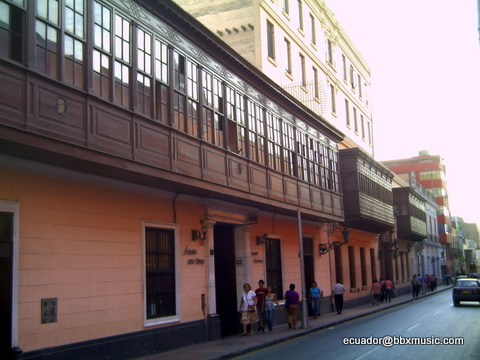
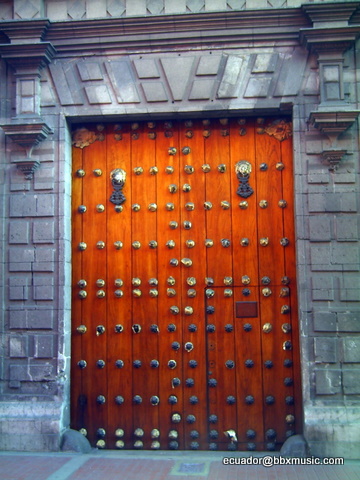
It’s a very beautiful place with lots of history. We wandered around
for a few hours exploring different places. One place we came upon must have been
the Presidents Palace or something like it as it was heavily guarded including an
active tank with a machine gun on top.
We left the Plaza Mayor around 5pm and started walking back towards
Miraflores. We came across a Metro (supermarket) so we were able to get some supplies
for breakfast. Then we came across are nice shop that sold the best ham I’ve ever
had, plus cheese, sandwiches and very good coffee. We had a couple of ham sandwich’s
made up for supper and bought ½ pound of coffee.
By now it was dark. All the shops were open and the place was buzzing
with more people than ever. So we flagged down a taxi. In the taxi we always wind
up the windows and lock the doors. People approach the taxi while you are stopped
at lights. Some are obviously trying to sell you something some their intentions
are less obvious as they have nothing in their hands and a bedraggled, dirty look
about them.
What a cool trip home we had.
Pierre tried his best to explain were we lived; in a club and gave the driver the
address for our friend’s house. We got on the motorway for 20 minutes then off and
ended up on the water front, at a gated community ‘club’ just not ours. It was a
very nice area we travelled in with fountains, lights etc. The next day I was to
learn that this was the coast of the Miraflores district.
Our taxi driver was very good. He stopped and asked for directions
from the police a couple of times. He was very patient. We enjoyed the trip as it
turned out to be a little ‘tiki tour’ of Lima at night. With directions and some
u turns we made it; we found our gated community; our club. We gave the driver much
praise and thanks and ensured he was paid well for his effort.
We ensure we encouraged that wonderful drivers we had so that they
will hopefully give more wonderful service and experiences to the next tourists
they pick up. You could have looked at our trip home very negatively as he didn’t
know the way and took us up hill and down dale. This cost us more because it took
longer. We got home an hour late etc. But what’s the good of looking at it that
way? This creates bad energy inside you and on the earth which leads to more bad
energy. He didn’t know the way, but he does now!! He did an excellent job a seeking
help from good sources and found his way. We got a very nice tour of Lima at night.
We saw some amazing light displays. One building high rise bank had these really
cool lines of lights that pulsed different colors across is façade. We saw the wonderful
area of Miraflores at night. Lima turned out to be a very beautiful city at night.
Emily had a sleep in the taxi. We arrived home safely and in joyfully good mood.
Emily wasn’t tired as she had had a sleep so was able to stay up happily with us
and talk with our friends. What better outcome to an awesome day of adventure could
you ask for?
We got back home around 8.30pm. Needless to say our friends were
getting a little worried about us as they hadn’t heard from us and it was dark and
late. They were very happy to see us home safely. We caught up with each other discussing
our day’s adventures over a good bottle of red wine and lovely ham sandwiches. We
crashed around 10pm. Just totally knackered from an awesome day outJ.
Tuesday started much like Monday with a good breakfast of fresh fruit
followed by fresh bread and butter and honey washed down by good strong black Peru
coffee (water for Emily). We were heading home on the night bus on Tuesday evening
so prior to going out to explore more of Lima we prepared our stuff and partially
packed our bags.
Then it was a taxi with our friends to Metro to look at the home
centre and compare prices.
Then it was in a taxi and back to Miraflores. Our friends stayed
at Metro. Where we had another lovely local lunch in a little very local restaurant.
Followed by the best ice creams we have had. They were delicious!!!!
We walked in a different direction to yesterday. We didn’t have any
particular sights that we wanted to see. We ended overlooking the beach/waterfront
area we had travelled on the previous night in the taxi. We found a beautiful park
that followed the top of ht cliffs. Miraflores is like a giant version of Mission
Bay in Auckland.
By now it was early afternoon so we decided to make our way home.
And to travel using local buses again. So we got on the bus and off we went. We
didn’t make it home on this bus. No we got off as we were passing through a very
nice area called Barranco.
 Bordering south of the business areas of San Isidro and Miraflores,
Barranco, with its 3 1/2 square kilometers and 40,000 inhabitants, is not only the
smallest but also the oldest of Lima's 22 districts. After officially being founded
in 1874, Barranco mainly used to be Lima's beach, pleasure and entertainment district.
Many wealthier Limeños had their summer- and weekend residences there.
Bordering south of the business areas of San Isidro and Miraflores,
Barranco, with its 3 1/2 square kilometers and 40,000 inhabitants, is not only the
smallest but also the oldest of Lima's 22 districts. After officially being founded
in 1874, Barranco mainly used to be Lima's beach, pleasure and entertainment district.
Many wealthier Limeños had their summer- and weekend residences there.
Fortunately Barranco was spared the fate of San Isidro and Miraflores,
where today the old colonial architecture of the Spanish conquistadores has been
replaced by modern office- and apartment buildings, shopping malls and recreation
centers. Here you can still find architectural contemporary witnesses of a boom
long gone, buildings that emanate the rather morbid Bohemian charm: the typical
wooden balconies with prim balustrades and house walls as colorful as the world
of comics: from blue to red, yellow, green, turquoise, pink and purple, the whole
a color palette. It almost seems as if these colors are meant as a contrast to the
rather scarce natural greens.
Barranco unfolds its most charming assets and exceptional character
away from the wide and busy avenues. If you stroll from Parque Municipal in front
of the public library down towards the Iglesia La Ermita, whose red facade glares
from afar, you will soon reach the wooden "Puente de los Suspíros". The
"bridge of sighs" is not only the hot spot for the young and old on weekends,
but also something like the district's landmark. The great Peruvian chansonière
Chabuca Granda honored the bridge by dedicating one of her songs to her. A memorial
near the bridge pays homage to the artist and her motif.
Nothing has changed until today. As it always was, young couples
meet there and sometimes send their big sighs of love towards the sky. Surrounded
by the many tiny inviting restaurants with terraces on which one can enjoy the evening
sun, a small footpath, the "Bajada de Banos" leads underneath the bridge
down the cliffs towards the ocean. All hustle and bustle, noise, and smell of the
city seems endlessly far away from here.
The few tourists finding their way to Barranco are provided with
an astonishing number of options in regards to cozy little bars, cafes, restaurants,
salsa and jazz clubs, for example the "Posado de Los Angeles", "La
Noche" or "Monos Morenas". These are all places that would attract
the same crowd if located in one of Germany's hip student districts.
http://www.livinginperu.com/blogs/travel/188
It is everything they say it is above. It is such a nice area that
we got off the bus to explore it. We went across and under the Bridge of Sighs.
Followed the cobbled path all the way down to the sea (and back up again). We visited
the lovely town square of Barranco where Emily played ball with some local kids
for a while. There used to be trams running in this area but they were closed down
5 years ago which is a real shame as they would have added an aspect of romance
and mystic to the area. Now they sit on the tracks as museums of an era gone by.
Again I would recommend visiting Barranco if you ever get to Lima.
Now the district of Lima that we were staying is quite large, bigger
than anything we have in NZ. We got on a bus in Barranco with the district name
on the side of it but had to get off as it was going to the wrong end of the district.
So we were standing on the side of the road wondering ‘okay which bus do we need
to get to go to Lima Sur – Metro centre (which is close to where we were staying).
We asked some nice girls who were waiting at the bus stop too and they were very
helpful and ensured we got the right bus this time. Sure enough 5 minutes later
we found ourselves in the familiar place of Lima Sur – Metro centre. Again not once
during the travels of this day did I feel concerned for our safety. I found the
people to be very polite, happy and helpful.
We called into Metro SUPER supermarket to get supplies for sandwiches
to take on the bus. The food on the bus is not good especially the ‘breakfast’ so
on this trip we wanted to be better prepared ourselves. I went in this time as Pierre
and found his way around the other day so it was so much of a jungle anymore. It’s
a strange set up. It’s not like half the store is set out to sell none food related
items and the other half set out to sell food related items. Like you would find
in say the The Warehouse in Syliva Park for example. No, you go down say the shoe
section and at the end of the shoe section is the bread section and then at the
end of the clothing section is the delicatessen. When you get to the canned goods,
pet food and cleaning products etc it resembles more of a ‘normal’ supermarket.
Then it was in another taxi home. This driver was a local to the
area so we didn’t get lost this time. We were home by 6 just enough time to finish
packing, prepare our food, say goodbye and get to the bus terminal on time.
I must say that Cruz de Sur bus service is a fairly organized set
up. Both in Lima and Piura the thermals are well run and efficient. We got a little
concerned when waiting in the queue in the terminal in Lima to get our boarding
passes. The security guard approached us and took our tickets. But it was all good!
He jumped the queue for us and got our boarding passes. Good service!
For the trip back we had gone 1st
class. It has bigger seats that go back a bit further. In first class you
get the same food as in second class. No gain there. We share the same stewardess
as second class so had to wait quite a while for our dinner trays to be cleared
away etc – so no gain there. First class is at the bottom, back end of the bus so
you don’t get the view as you do in second class which is up stairs – no gain there.
The first class toilet is shared with the second class people – no gain there. You
get the same bad movies – no gain there. And on this particular bus we were serenaded
all night long by the grinding of brakes and wheels and the air conditioning unit
plus the road noise. It’s a lot quieter in 2nd class. So you are paying
an extra $10 per person for a bigger seat.
Fortunately again no one snored or farted again on this trip. It
would be horrible if someone farted as you are in a small enclosed ‘cabin’ that
seats 9 people with no windows that open. And to be stuck there all night with a
snorer ……. L
This is a good example of when paying more is not necessarily better.
I recommend travelling 2nd class.
With little or no sleep (except Emily she slept well) we found ourselves
in Piura at midday.. That’s beauty of kids they can sleep anywhere. How do we manage
to lose this skill as we grow older? It is one we should endeavor to keep.
It was HOT in Piura. We basically went from a very comfortable 26\8
in Lima to 36\8 in Piura. When we got off the bus and out of the air conditioning
it hit you square on. It took a moment to catch your breath. And from then on it
was an uncomfortable heat.
Again we managed to pick a very helpful taxi driver. It was hot in
the taxi, sweltering hot. You can’t put the windows down due to the risk and there
is no air conditioning. After an hour of ferrying us around Piura looking at different
Hotels and Hostels we found one that was not too expensive, clean, appeared safe
and within walking distance to the place we wanted to eat. We gave the driver much
thanks, ensured he was well paid and booked him to pick us up in the morning.
We ensure we encouraged the wonderful drivers we havee had so that
they will hopefully give more wonderful service and experiences to the next tourists
they pick up.
In Piura I found my guard was up more than in Lima. This was probably
due to the fact that we didn’t have the sanctuary of our friend’s home to return
to or the knowledge that we could call them for their help if needed like we had
in Lima. We were on our own. Also, Piura is clearly a poorer city then Lima and
it is smaller with no real obvious ‘touristic’ areas.
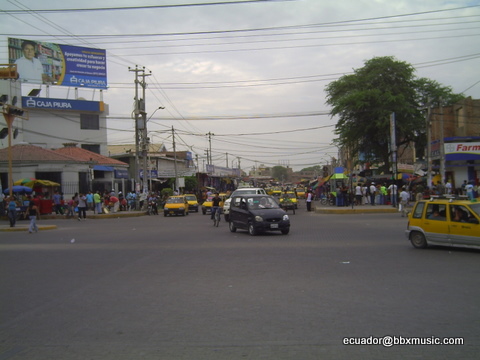
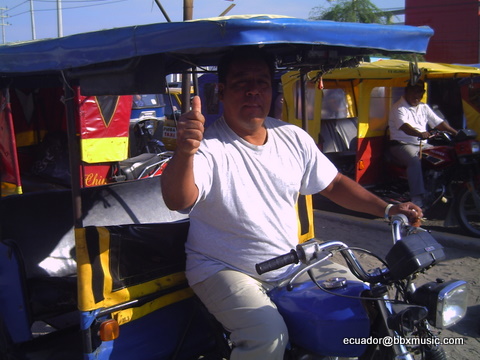
Our taxi driver showed us where the local restaurants are and after
we settled into our room we found the street again (after getting directions from
a security guard and yet another helpful taxi driver). We had another lovely local
meal. Then we went for a wonder around and found an ice cream parlor with a security
guard watching over it! The ice cream was more like we have in NZ ‘Tip Top’. It
was still good but the one we had in Lima will stay with me forever.
By now I was feeling beyond tired. So I opted to go back to the hostel
with Emily. Pierre went off in search of a motor bike shop he had seen on the way
in the taxi to compare prices. This is the first time we split up. It was 4 pm by
now and the streets were getting busier. Walking alone on the streets with Emily
did make my guard go up further. But we had absolutely no problems. I knew exactly
the right way back to the hostel. It wasn’t a long distance about 8 minutes walk.
We had a shower and crashed. Emily and me were asleep by 5 pm. Pierre
came back shortly after 5 and we were all out like lights by 6 to 6am.
Today was the last leg of our trip back to V. The taxi driver was
there ahead of our arranged time, very efficient. He took us the short distant to
the Co-operative Loja Bus Terminal. We were 1 ½ hours early for the bus so we were
able to go and look at some of the hardware\bathroom shops that are next to the
terminal. The bus departed on time and it was not full. We meet several English
speaking people on the Loja bus. There was Liza from Australia, Ken and Bonnie and
Sylvester, Francesca, and Connie from Poland\Peru. There was another Aussie couple
and their two boys on board but they didn’t say boo to no one the entire trip. I
never saw the boys move in their seats and only heard them talk once during the
10 hour bus trip. So I never got to know their names.
We crossed the border again back into E without any problems. The
border crossing took about an hour due to the amount of people that had to be processed
on the bus. The border crossing was the only time we got off the bus.
Once in E we never got off the bus. It would stop at towns to pick
up short distance passengers and then drop them off. But we long distance travelers
never had time to get off as these stops were very short. There is a toilet on board
the bus just in case any of you are wondering how we met natures call.
Ecuador looked like a first class country compared to Peru. The houses
in E are nicely maintained when you compare to Peru. The towns in E are clean compared
to Peru. There are no mud brick shacks. Even the worst house in E looks like a palace.
It was refreshing to be in E.
It was a long trip back through the winding mountains roads on a
bus. We got in Loja around 6.30 pm we were very happy to see little old Loja again
after the big cities we had been in Peru. We caught a taxi to Supermaxi and had
some takeaway food in the food court, did some shopping and jumped in a cab for
the final hour back to V.
It was good to be back in familiar surroundings. We crashed.
In conclusion
We managed to find 3 of the best tourist’s spots to visit in Lima
without using a map, tour, or guide just through following our noses. Lima is very
clean and tidy compared to Piura and the desert. Many streets are nicely painted
with small parks in the middle of the road that run the length of the road with
cycle ways and walk ways in them.
We found the temperature in Lima to be very good. It is very pleasant
during the day and a just a little chilly at night so that if you are outside at
night you need to put on a light jumper.
We did not visit any markets or ‘risky’ areas and stuck to the main
areas. I must say that I found Lima to be safe in these circumstances.
Would I recommend Lima as a place to go and visit - Yes. But I feel
it is more suited to the open minded, alert, switched on, tourist. You have to remember
where you go so you can find your way back without getting lost. You have to be
able to move around without carrying a map for example. You have to select the people
you approach for directions and help and select your taxi too. Not just jump into
the first on you see.
I found traveling by bus over these long distances harder and more
tiring than doing a 24 trip in a plane. It really knocked the stuffing out of me
for days. It’s taken several good nights’ sleep to recover.
And what we travelled by bus in nothing. Our friend Bruce (who is
from Canada) said he did a 3 day bus crossing of Canada. The bus stops for 1 hour
every 8 hours or so to allow you to stretch your legs and that’s it! 3 days nonstop
on a bus.
I want to thank our friend’s family in Lima who helped make our trip
stress free and gave us a wonderful place to rest. They are very lovely people
who I would like to see again one day.
I’d like to thank the friends that we traveled with who held our
hands across the border the first time, gave us good advice and great company.
I would like to thank the people in Lima who gave us directions and
helped us and the many great taxi drivers we had.
Would I go back to Peru – Yes. To different places though as there
is some much to see there. I would like to visit Lima again to say hello to the
lovely people we met there.